One Cub Scout ca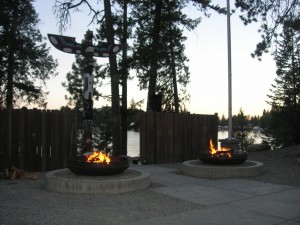 mp is a family camp, and the families of the Cub Scouts are invited to come. The camp takes place near a lake in our area. As soon as we arrive on the campgrounds, we need to set up our tent. Then the children (and any adults who want to go boating or swimming) take a swim test. If you are considered a non-swimmer, you can’t go out alone with another non-swimmer. There has to be one swimmer on each boat. Also, there is a trampoline in the lake, and your child can swim to it on his own if he passed the swim test. Otherwise he has to wait for an adult to go with him. All the boys wear life vests unless they are taking the swim test on the first day.
mp is a family camp, and the families of the Cub Scouts are invited to come. The camp takes place near a lake in our area. As soon as we arrive on the campgrounds, we need to set up our tent. Then the children (and any adults who want to go boating or swimming) take a swim test. If you are considered a non-swimmer, you can’t go out alone with another non-swimmer. There has to be one swimmer on each boat. Also, there is a trampoline in the lake, and your child can swim to it on his own if he passed the swim test. Otherwise he has to wait for an adult to go with him. All the boys wear life vests unless they are taking the swim test on the first day.
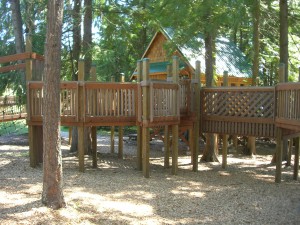 The boys are divided into groups, and the groups go through six different stations during the three days we are there. The stations include BB gun shooting, archery, crafts, orienteering, geology in the treehouse area, and waterfront activities. The waterfront activities this year were water basketball and water volleyball. During elective time, there are swimming activities, boating, fishing, marbles, chess, badminton, knot tying, astronomy, and bike riding. The orienteering included instruction on how to use a compass and how to orient a map. We went on a short hike using our compasses. BB Guns and archery can only happen at camp, where everything is gated off, and the boys are given safety precautions. Everything happens slowly and deliberately. For example, “Notch your arrow to your bow string,” is one command. The instructor waits until everyone does this one step. Then he gives instructions for the next step. This way when everyone shoots, it’s the safest environment possible.
The boys are divided into groups, and the groups go through six different stations during the three days we are there. The stations include BB gun shooting, archery, crafts, orienteering, geology in the treehouse area, and waterfront activities. The waterfront activities this year were water basketball and water volleyball. During elective time, there are swimming activities, boating, fishing, marbles, chess, badminton, knot tying, astronomy, and bike riding. The orienteering included instruction on how to use a compass and how to orient a map. We went on a short hike using our compasses. BB Guns and archery can only happen at camp, where everything is gated off, and the boys are given safety precautions. Everything happens slowly and deliberately. For example, “Notch your arrow to your bow string,” is one command. The instructor waits until everyone does this one step. Then he gives instructions for the next step. This way when everyone shoots, it’s the safest environment possible.
Crafts include leath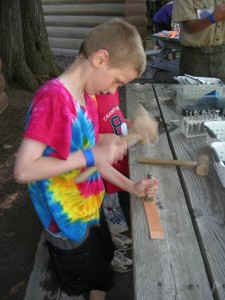 er crafts, bead work, and woodworking. This year there was no woodworking because we made model rockets instead, which the boys blasted off on the last day. The boys also played with some weird colored sand that always stayed dry, even when you added water. The boys pounded different stamps into their leather bookmark. Last year the boys made a leather pouch for marbles. They also pounded together a wooden treasure chest with nails, and then decorated it. The year before, the boys made a wooden bug catcher with an iron netting stapled to it. Twice the boys made a key chain out of beads. Bead work is harder than wood working and takes longer.
er crafts, bead work, and woodworking. This year there was no woodworking because we made model rockets instead, which the boys blasted off on the last day. The boys also played with some weird colored sand that always stayed dry, even when you added water. The boys pounded different stamps into their leather bookmark. Last year the boys made a leather pouch for marbles. They also pounded together a wooden treasure chest with nails, and then decorated it. The year before, the boys made a wooden bug catcher with an iron netting stapled to it. Twice the boys made a key chain out of beads. Bead work is harder than wood working and takes longer.
The food is served at the cafeteria, and two Scouts from each table volunteer to be waiters. They bring the food to the table, and afterwards clear the table and wipe it off. A flag ceremony occurs in the morning and at night before eating, and the Scouts wear their uniforms. The boys salute and show honor to our flag and our country.
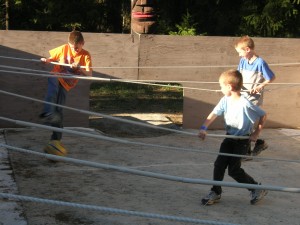 After dinner each night, a Turbo Rush is blown up, and the children run through it. It’s kind of like a big, puffy trampoline with a slide at the end. The boys also play human fooseball. A rectangle of wood is entered, with a hole on each end for the goals. Ropes hang across the area, and PVC pipe pieces are connected to the rope, at each place where a boy would stand. The boys hold on to their PVC pipe, which slides across the rope. A soccer ball is thrown into the area, and a soccer game is played, with no one allowed to let go of his PVC pipe. It’s actually quite fun for the boys.
After dinner each night, a Turbo Rush is blown up, and the children run through it. It’s kind of like a big, puffy trampoline with a slide at the end. The boys also play human fooseball. A rectangle of wood is entered, with a hole on each end for the goals. Ropes hang across the area, and PVC pipe pieces are connected to the rope, at each place where a boy would stand. The boys hold on to their PVC pipe, which slides across the rope. A soccer ball is thrown into the area, and a soccer game is played, with no one allowed to let go of his PVC pipe. It’s actually quite fun for the boys.
A campfire follows t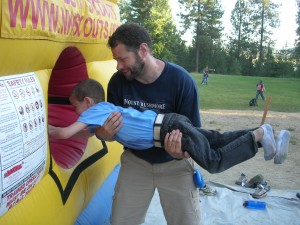 he games around 8:30 or 9 pm, when it’s dusk. The first night the talent show is put on by the camp counselors. Many skits, songs with hand movements, and jokes are told. The boys laugh and have a good time. The second night the Scouts themselves are involved in the skits. The camp counselors usually help each camping section to come up with a skit to present.
he games around 8:30 or 9 pm, when it’s dusk. The first night the talent show is put on by the camp counselors. Many skits, songs with hand movements, and jokes are told. The boys laugh and have a good time. The second night the Scouts themselves are involved in the skits. The camp counselors usually help each camping section to come up with a skit to present.
Finally, the Scouts go to bed in their sleeping bags in a tent. Stargazing happens on the final night. If you take the top off your tent, you can look up at the stars as you fall asleep.


